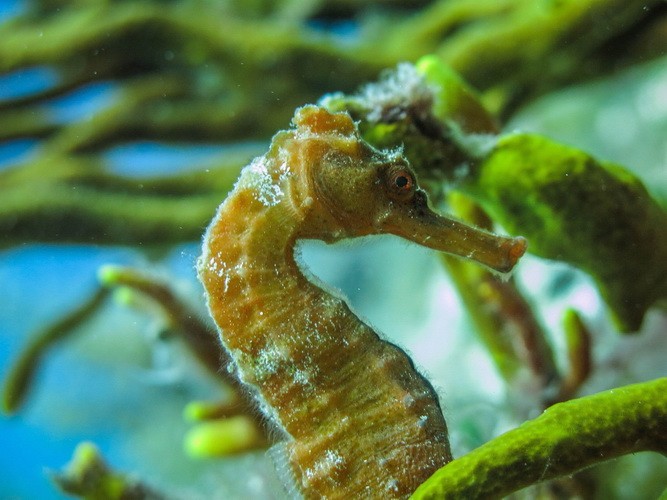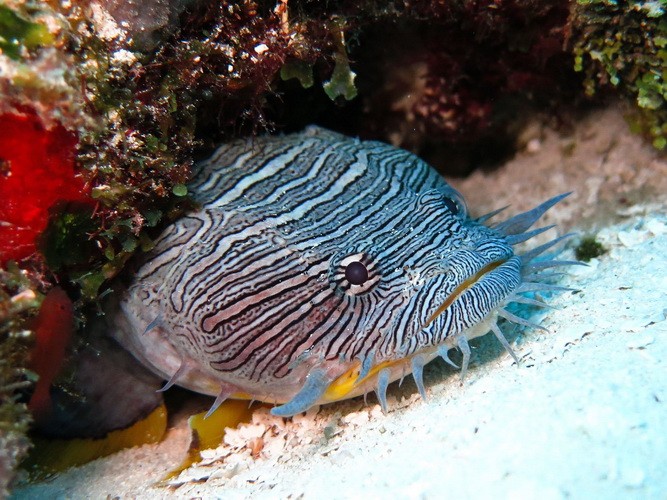Cozumel Reefs
The best Dive and Snorkel Sites
Cozumel Coral Reefs: Fascinating Underwater World
Das Korallenriff auf Cozumel ist nach dem Great Barrier Riff das zweitgrößte Barrier-Riff weltweit. Damit ist es das größte Riff des atlantischen Ozeans und beginnt im Norden von Yucatan bei der Insel Contoi. Von dort erstreckt es sich über die gesamt Küste im Südosten von Mexiko, Belize und Guatemala bis hin zur Bay of Islands in Honduras. Das faszinierende Riffsystem beheimatet über 500 Fischarten und 60 Steinkorallenarten.
Das als mesoamerikanische Riff bekannte System besteht aus Atollen, Riffen, Lagunen und Seegraswiesen. Verschiedene Nationalparks schützen Teile des großen Korallenriffes. Beispielsweise kümmert sich der Nationalpark Arrecifes de Cozumel mit verschiedenen Projekten um die Korallen-Riffe auf Cozumel. Fast die ganze Insel Cozumel ist von Korallenriffen umgeben. Dabei verläuft das Cozumel Riff paralell zur Küste und ist leicht mit dem Boot zu erreichen.
-

Private Cozumel Jeep Tour
$110.00 (from) -

Cozumel Highlights
$140.00 (from) -

Snorkeling & Beach Club
$120.00 (from) -

Tulum Express Private Excursion
$200.00 (from) -

Tacos & Bar Hop Tour Cozumel
$90.00 (from) -

Animal Sanctuary & Island Tour
$120.00 -

ATV & Beach Break Tour
$130.00 (from) -

Cozumel Diving
$140.00 (from)
Unique fish and colorful coral reef on Cozumel

Coral Reefs Cozumel: Turtle
Taucher und Schnorchler aus aller Welt kommen nach Cozumel, um den Fischreichtum und die bunten und intakten Korallen zu bewundern. Denn an den wunderschönen Cozumel Korallen-Riffen leben viele geschützte Meereslebewesen. Einige davon gibt es nur in diesem Teil der Karibik. Dazu gehört zum Beispiel der blau-weiß gestreifte Korallen-Krötenfisch mit seinen gelben Flossen.
Am Cozumel Korallen-Riff lassen sich vier der sieben weltweit existierenden Arten von Meeresschildkröten finden. Dazu gehören die Grüne Schildkröte, die Echte und die Unechte Karettschildkröte und die Lederrückenschildkröte. Besonders während der Saison zwischen Mai und September kommen weibliche Schildkröten von den Cozumel Korallen-Riffen an Land und vergraben ihre Eier im Sand. Deshalb sind einige Strände zu dieser Zeit besonders geschützt.
Weitere faszinierende Lebewesen wie Adlerrochen (Dezember bis Februar), Ammenhaie, Bullenhaie (Dezember und Januar), aber auch Mantas und Walhaie (Juni bis September) leben im mexikanischen Teil des Korallen-Riffes.
The coral reefs of Cozumel in the south
Devil’s Throat and Punta Sur with Cathedral (90 – 120 feet)

Devil’s Throat on Cozumel: Reefs in the south
Ganz im Süden der Insel liegen die Cozumel Riffe des berühmten Devil’s Throat und Punta Sur. Der ‚Rachen des Teufels‘ ist ein spektakulärer Tunnel, der sich von 38 Meter auf 30 Meter hinzieht. Durch die Tiefe und die Höhlen ist ‚Devil’s Throat‘ nur für erfahrene Taucher mit sehr guter Tarierung und kontrolliertem Luftverbrauch geeignet.
Teil vom südlichen Korallen-Riff auf Cozumel ist auch die ‚Cathedral‘, ein spektakulärer Raum unter Wasser. Die Felsen erinnern an die langgezogenen Fenster einer Kathedrale. Daher der Name. Aufgrund der Tiefe lassen sich die beiden Tauchgänge im Süden nicht miteinander verbinden. Wir betauchen daher entweder Devil’s Throat oder Punta Sur.
Cozumel Coral Reefs: Colombia (17-35 meters)

Nurse shark on Cozumel reef Colombia
Like almost every Cozumel reef, Colombia has a shallow part between 15 – 30 feet. This part of the Colombia reef on Cozumel is perfectly suitable for snorkelers. Also new divers are taken to the shallow part of the Colombia reef for training dives.
Cozumel Reef: Palancar (10 – 30 meters)

Eagle Ray on Cozumel reefs Palancar reef
Well known are the dive sites; Palancar Bricks, Palancar Caves, Palancar Horseshoe, Palancar Gardens, Francesa and Dalila. All those Cozumel reefs are completely different. This demonstrates how large and diverse this area is. While Palancar Caves has beautiful caves and swimthroughs, Palancar Gardens and Francesa are magnificent tunnel systems under the reef.
The shallow part of the Palancar reef on Cozumel is just perfect for snorkeling. Discover abundant fishs, sometimes turtles or even a nurse shark, and during the season eagle rays can be seen from the surface.

Wie bei den meisten Korallen-Riffen auf Cozumel hat Paso de Cedral eine Steilwand und etwas innerhalb davon das eigentliche Riff. Dabei sind beide Teile des berühmten Cozumel Riff Paso de Cedral reizvoll und völlig unterschiedlich.
Paso de Cedral ist einer der beliebtesten Tauchplätze von Cozumel. Vor allem die zahlreichen Grünen Schildkröten begeistern viele Taucher. Denn sie kommen zur Nahrungsaufnahme in die Nähe der Steilwand und sind dort vermehrt anzutreffen. Dabei werden sie oft von Kaiserfischen begleitet, die sich an den losgelösten Korallenstückchen laben.
Der Ammenhai und die grüne Moräne auf dem Bild bewohnen gemeinsam einen Felsüberhang am Ende des Riffes. Mit etwas Glück sind die beiden dort gleichzeitig anzutreffen.
Auch das Santa Rosa Riff auf Cozumel besteht aus einer Steilwand und dem inneren Korallen-Riff. Etwas ganz besonderes sind die faszinierenden Höhlenformationen in der stark abfallenden Steilwand. Das flache Santa Rosa Riff ist ein flaches und einfaches Riff. Es ist hervorragend zum Schnorcheln und für Tauchanfänger geeignet.
Yucab and Tormentas reefs on Cozumel (36 – 60 feet)

Sea horse on Yucab reef Cozumel
Various overhangs and holes are perfect lairs for creatures. Toadfish, lobsters and huge crabs hide here. Sometimes nurse sharks sleep under overhanging rocks. Divers with very good eyes can look for seahorses during their season in October and Novermber.
Paraiso und Chakanaab reef on Cozumel (30 – 45 feet)

Toad fish on Paradaise reef Cozumel
Paraiso is especially popular for night dives. The Caribbean Reef Octopus is active at night time and can be seen.
Cozumel reefs in the north
Barracuda reef on Cozumel (45 – 100 feet)

Barracuda at Barracuda reef Cozumel
The great barracuda lives in this dive site. Thus the name Barracuda reef. Here you will dive far away from other divers. Only few Cozumel dive shops go that far north.
Cantrell Wall reef on Cozumel (66 – 100 feet)

Eagle ray on Cozumel reefs
Because of the strong currents a certain level of experience in diving is required. It is a very impressive but demanding dive site.
Summary
- Cozumel is located on the second largest barrier reef in the world
- The Palancar Reef on Cozumel belongs to the famous dive sites
- Eagle rays, turtles, nurse sharks and toad fish are among the special marine life on Cozumel
AFFILIATE LINKS
This article contains product recommendations in the form of affiliate links. If you buy something through these affiliate links, we get a small commission. This does not change the price for you.

Hello, my name is Birgit and I write about interesting topics around vacations in Mexico and traveling on the Yucatan peninsula. I would love to hear from you and I am always happy to receive ideas and recommendations for new articles.
Enjoy reading!!!
Follow us
Further interesting blog posts

High quality tequila: Recommendations from Mexico
Tequila from Mexico How to recognize High Quality TequilaHigh Quality Tequila: Recommendations from MexicoOne of Mexico’s most popular souvenirs is tequila. It is the most famous form of the Mexican national drink Mezcal and is extracted from the heart of the blue...

Biodegradable sunscreen
Biodegradable Sunscreen Coral ProtectionBiodegradable sunscreen: Coral ProtectionA special consideration for the vacation luggage to Mexico should be the right sunscreen. Because we have to protect our skin against the strong sun and dangerous UV rays. However, the...

Cenotes in Mexico
Cenotes in Mexico The best Cenotes of the Riviera MayaThe best cenotes in Mexico: Magic OasesLovely, but mystical and full of secrets; the cenotes of the Yucatan Peninsula are a true gift of the nature. Swimming in a cenote, surrounded by jungle and rock formations,...

The History of the Maya: An Introduction
History of the Maya Between Myths and Knowledge: An IntroductionHistory of the Maya: An IntroductionThe Maya were excellent mathematicians, architects, astronomers, doctors and very religious people. Their daily life was permeated with rituals and ceremonies. Native...

The best mosquito repellent for Mexico
The best mosquito protection For Mexico and the CaribbeanThe best mosquito protection for Mexico and the CaribbeanThe vacation is booked - off to Mexico and the Caribbean. The anticipation of balmy summer nights, tropical rainforests and dream beaches rises!!! If only...

Chichen Itza Travel Guide
Travel Guide Chichen Itza History | Arquitecture | Insider TippsChichen Itza: Travel Guide into the Mayan WorldIt is a once in a lifetime opportunity to see the famous Mayan ruins of Chichen Itza. For many visitors, the culture of ancient Mexico has so much...




